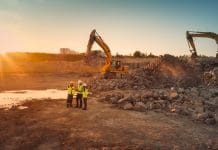When we consider building safety and the Golden Thread, we asked BIM Academy’s managing director Dr Graham Kelly and Ryder Architecture’s safety director Allan Binns how we turn the ambitious requirements of the revised Building Safety Act into a reality for the built environment by October 2023?
On 28 April 2022, the Building Safety Bill received Royal Assent and became an Act of Parliament. This landmark act was set to bring about historical change to building legislation in the AEC industry.
The first draft of the Building Safety Bill was issued in July 2020 following an independent review of Building Regulations and fire safety carried out by Dame Judith Hackett. It is the main legislative response to the Grenfell Tower disaster and takes forward a selection of Dame Judith’s review recommendations.
The act contains provisions intended to secure the safety of people in or about buildings through the creation of a national framework that will, “create lasting generational change”.
From inception through to Royal Assent, the Building Safety Act has undergone a significant transformation. The journey so far has proved it will be an ever-evolving process with far reaching implications.
Initial talks centred on safety measures during the design and construction of new high-rise buildings. However, new legislation now stretches from the procurement stage all the way through to operation.
What new legislation has been set out in the Building Safety Act?
Allan: The Building Safety Act (BSA) is far-reaching, affecting not just “buildings in scope” (18m or seven storeys with two or more residential units), but impacting on all future building projects.
However, while elements of the BSA will apply to all projects, it is legislation surrounding high-rise residential buildings (HRRBs) in England that have become a central focus for the industry.
The safe design and construction of these HRRBs will now be underpinned by a gateway process to:
1. Ensure early consideration is given to fire safety.
2. Manage change control.
3. Preserve the integrity of the building and fire safety information.
While this new structure has been hitting the headlines, arguably the most significant change comes in the occupation phase with the advent of the Accountable Person (AP).
An AP is the organisation or person who owns or has responsibility for the building. Under the BSA, they will have an overarching duty to take all reasonable steps to prevent a building safety risk (eg spread of fire and/or structural failure) from happening and reduce the seriousness of an incident if one happens.
The AP will achieve this through the production and maintenance of a building safety case.
Tell us more about the targets that have been set for October 2023 relating to high-rise buildings
Allan: An AP must register all of their existing HRRBs with the Building Safety Regulator (BSR) between April and October 2023. It is an offence if a building is occupied but not registered after October 2023.
An AP will be required to register any newly built HRRBs with the BSR before occupation after this date.
In England, and from October 2023, an AP must prepare and maintain a building safety case for each of their HRRBs, making a building safety case report available to the BSR at set periods and upon request.
The safety case is all the information you use to manage; the risk of fire spread and the structural safety of your building. The safety case report is a document that summarises your safety case.
It may be best understood as a structured argument on how a HRRB is safe for occupation. Effectively, it is a risk assessment evidencing the control measures that have been implemented (fixed assets) and continue to be implemented (dynamic elements) to mitigate spread of fire, structural failure and reduce the seriousness of an incident if one should happen.
Is there enough education and understanding within the industry to realise this target?
Graham: I don’t think there is enough education, there are a lot of clients with their heads in the sands, waiting to respond, once this is a legal requirement. Unfortunately, I don’t think this is going to be good enough in this case. The act is really pushing for a proactive approach by clients, making sure they are ready for October 2023 or at the very least have a plan of how to respond to the legislative changes.
I understand that there are huge pressures on the residential sector at the moment. But the only way to turn these pressures into advantages is through education. The new act forces clients to manage and maintain information better. Within this, there are vast opportunities to improve the operation of buildings, as well as ensuring their safety, providing better overall outcomes, costing less to run, better places for people to live, high values etc. These new opportunities naturally require a vast amount of education, we are very much focusing on the knowledge required to comply, as well as the digital skills and knowledge required to do this efficiently.
How does the Golden Thread come into this? What is your view of what an effective Golden Thread actually looks like and who is responsible for its implementation?
Graham: The Golden Thread is a term that is potentially overused and has many different connotations. I believe the Golden Thread is the specification, creation, collation, management and maintenance of information on a project. With regards the Building Safety Act, this information is associated to the spread of fire and structural integrity.
Allan: The AP is responsible for ensuring the implementing of the Golden Thread for their building. I would say that the most effective utilisation of a Golden Thread, will be one that goes beyond fire and structural safety, one that carries on all the way into operational excellence.
What steps, as an industry, do we now need to take to fully comply with the Building Safety Act?
Graham: This new compliance is a huge change for our industry. Awareness and education are the first elements, and right now secondary legislation is still being published, although we understand the main aspects, this is still a moving target. Clients need to stay on top of this, there will come a time when jail terms are possible for noncompliant APs.
However, beyond the awareness piece, clients need to devise a strategy for implementation specific to their portfolio (current and future). This strategy needs to consider the specification, creation, collation, management and maintenance of information that as a minimum is associated to the spread of fire and structural integrity.
There is a lot to take in from the new BSA, new legislation and new reporting and recording methods. We only have until October 2023 to fully understand what is needed and put these measures in place. It will be a challenge, but a very much needed next step in building safety.

Dr Graham Kelly
Managing director
BIM Academy
Tel: +44 (0) 191 269 5444


















